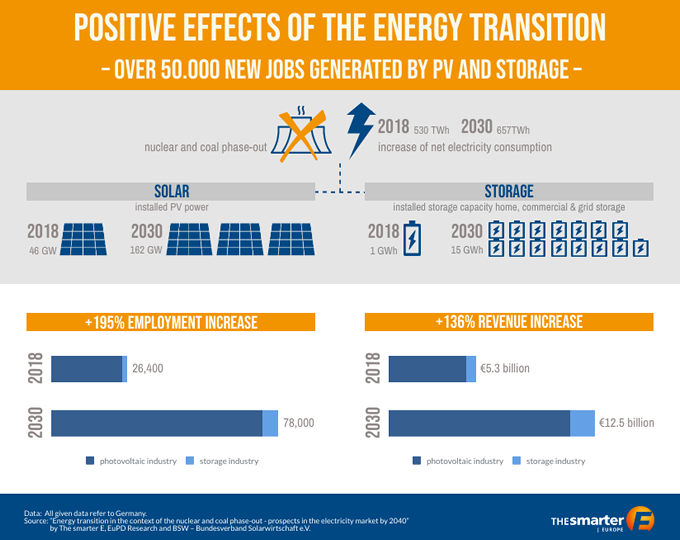More than 50,000 new jobs through photovoltaics and storage technology
In order to avoid a shortfall in electricity generation as a result of the nuclear and coal phaseout, photovoltaic and storage capacities must be expanded at a far greater pace. By the year 2030, this would enable the creation of over 50,000 new jobs in Germany. This is one of the findings of a current study by the Bonn marketing and social research company EuPD Research.

According to the study, the number of jobs in the domestic photovoltaic and storage industries could increase from today’s level of 26,400 to 78,000 by the year 2030. Industry revenue would grow from five to 12.5 billion euros in the coming decade. Job growth would take place for the most part in the fields of planning, installation, operations and maintenance of PV systems. In the area of maintenance alone, employment numbers would increase from 9,200 to 26,000 in the year 2030. Addition potential could be opened up by tapping into the market potential of medium- to long-term storage systems.
The German Solar Association (BSW-Solar) calls upon the German government to now move quickly to eliminate existing barriers to investment, and to correct the expansion targets for solar technology that are defined in its climate protection program. The Federal Government must finally act on the promise it has repeatedly made in recent weeks and scrap the 52-gigawatt cap in the Renewable Energy Sources Act (EEG). Unless this happens, there is a real risk that a market slump will occur in the solar industry after 2020, and that this, coming on the heels of the downturn in the wind power sector, will counteract climate protection efforts and jeopardize thousands of jobs in Germany. BSW Managing Director Carsten Körnig warns: “Time is running out, and further delays are irresponsible! The 52-gigawatt mark will already be reached within a few months.”
The study “The Energy Transition in the Context of the Nuclear and Coal Phaseout – Perspectives in the Electricity Market to 2040,” conducted by the Bonn-based marketing and social research company EuPD Research, provides a forecast of electricity supply and demand in Germany that is accurate to the quarter-hour. In order to avoid a power generation shortfall as a result of the closing of conventional power plants and rising electricity consumption, the study outlines a necessary growth trajectory of 10 gigawatts of annual photovoltaic installation. This PV expansion must be accompanied by a significant increase in storage capacity.
There are significant employment effects associated with a forecasted cumulative photovoltaic capacity of 162 GW and a capacity of 15 gigawatt hours of residential, commercial and grid storage systems in the year 2030.
According to market research analyses, in the year 2040 the solarization of the energy supply system will allow the electricity price to drop to under 29 cents per kilowatt hour.
The study “The Energy Transition in the Context of the Nuclear and Coal Phaseout – Perspectives in the Electricity Market to 2040” was developed in cooperation between BSW-Solar, EuPD Research and The smarter E Europe. The project is supported by BayWa r.e., E3/DC, Fronius, Goldbeck Solar, IBC Solar, Panasonic, SHARP, SIEMENS, sonnen, SUNTECH, TESVOLT and VARTA.
The complete study is available here:
http://bit.ly/thesmartere-study-PM
Comments (0)
This post does not have any comments. Be the first to leave a comment below.
Featured Product

